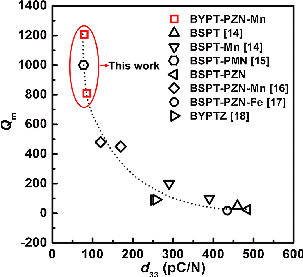
Fabricating Low Cost High Curie Temperature Piezoceramics with Large Mechanical Quality Factor
Aug 15, 2014 Email"> PrintText Size

Piezoelectric ceramics with a Curie temperature (Tc) higher than that of the conventional PZT have recently received a great deal of attention for application in sensors and actuators working at elevated temperatures, particularly, for aerospace and automotive industries. High Tc and high piezoelectric response were recently achieved for a new type of perovskite systems with the general form BiMeO3-PbTiO3 (BMePT), where Me can be a single or mixture of cations with an average valence of +3.
Nevertheless, the very low mechanical quality factor (Qm) of BMePT severely limits their application, particularly for high power devices. Therefore, low cost complex perovskite high temperature piezoelectric ceramics with a much higher Qm are highly desirable. Among the BMePT type piezoelectric ceramics, BYPT (BiYbO3-PbTiO3) has a high Tc up to 630◦C, and its piezoelectric properties and stability could be improved by adding another component with a low tolerance factor such as PZN. However, the ternary system BYPT-PZN still has a low Qm.
In this research, the variable doping element Mn was selected as a dopant due to its multiple modification effects, and the microstructure and electrical properties of Mn doped BYPT–PZN system with a composition of 0.6(0.1BiYbO3-0.9PbTiO3)-0.4Pb(Zn1/3Nb2/3)O3 possessing the optimum performance were investigated. It was found that, after addition of Mn, the Qm of the system was significantly increased (see Fig.1), implying decreased energy dissipation during vibration. Meanwhile, the piezoelectric performance showed only a slight decrease. Suitable amount of Mn also enhanced the Tc of the system.
The results indicated that the improved mechanical quality factor could be attributed to the improved density as well as the hard type doping effect of Mn. The optimum properties were obtained for the sample with around 0.75 mol% of Mn, whose Qm, d33 and Tc are 809, 86 pC/N and 416.5◦C, respectively. Direct high temperature d33 measurement via the Berlincourt method indicated that depolarization temperature in the sample with the best overall performance was higher than 300◦C.

Fig.1 Qm and d33 data of some high Tc perovskite piezoelectric ceramics (Image by WANG).
This research was supported by the ‘100 Talents Program’ of Chinese Academy of Sciences, the National Key Basic Research Program of China (973 Program, Grant No. 2013CB632900), China Postdoctoral Science Foundation funded project (No. 2014M550852). The authors also thank the Open Foundation of the State Key Laboratory of New Ceramics and Fine Processing of Tsinghua University.
References:
WANG Yunli, CAI Kai, JIANG Feng, ZHANG Junying, GUO Dong. Mn Doped Hard Type Perovskite High-temperature BYPT–PZN Ternary Piezoelectric Ceramics. Sensors and Actuators A: Physical (Vol. 216, 12 June 2014, pp.335–341). DOI: 10.1016/j.sna.2014.05.009
Contact:
GUO Dong
Institute of Acoustics, Chinese Academy of Sciences, Beijing 100190, China
E-mail: dong.guo@mail.ioa.ac.cn
Piezoelectric ceramics with a Curie temperature (Tc) higher than that of the conventional PZT have recently received a great deal of attention for application in sensors and actuators working at elevated temperatures, particularly, for aerospace and automotive industries. High Tc and high piezoelectric response were recently achieved for a new type of perovskite systems with the general form BiMeO3-PbTiO3 (BMePT), where Me can be a single or mixture of cations with an average valence of +3.
Nevertheless, the very low mechanical quality factor (Qm) of BMePT severely limits their application, particularly for high power devices. Therefore, low cost complex perovskite high temperature piezoelectric ceramics with a much higher Qm are highly desirable. Among the BMePT type piezoelectric ceramics, BYPT (BiYbO3-PbTiO3) has a high Tc up to 630◦C, and its piezoelectric properties and stability could be improved by adding another component with a low tolerance factor such as PZN. However, the ternary system BYPT-PZN still has a low Qm.
In this research, the variable doping element Mn was selected as a dopant due to its multiple modification effects, and the microstructure and electrical properties of Mn doped BYPT–PZN system with a composition of 0.6(0.1BiYbO3-0.9PbTiO3)-0.4Pb(Zn1/3Nb2/3)O3 possessing the optimum performance were investigated. It was found that, after addition of Mn, the Qm of the system was significantly increased (see Fig.1), implying decreased energy dissipation during vibration. Meanwhile, the piezoelectric performance showed only a slight decrease. Suitable amount of Mn also enhanced the Tc of the system.
The results indicated that the improved mechanical quality factor could be attributed to the improved density as well as the hard type doping effect of Mn. The optimum properties were obtained for the sample with around 0.75 mol% of Mn, whose Qm, d33 and Tc are 809, 86 pC/N and 416.5◦C, respectively. Direct high temperature d33 measurement via the Berlincourt method indicated that depolarization temperature in the sample with the best overall performance was higher than 300◦C.

Fig.1 Qm and d33 data of some high Tc perovskite piezoelectric ceramics (Image by WANG).
This research was supported by the ‘100 Talents Program’ of Chinese Academy of Sciences, the National Key Basic Research Program of China (973 Program, Grant No. 2013CB632900), China Postdoctoral Science Foundation funded project (No. 2014M550852). The authors also thank the Open Foundation of the State Key Laboratory of New Ceramics and Fine Processing of Tsinghua University.
References:
WANG Yunli, CAI Kai, JIANG Feng, ZHANG Junying, GUO Dong. Mn Doped Hard Type Perovskite High-temperature BYPT–PZN Ternary Piezoelectric Ceramics. Sensors and Actuators A: Physical (Vol. 216, 12 June 2014, pp.335–341). DOI: 10.1016/j.sna.2014.05.009
Contact:
GUO Dong
Institute of Acoustics, Chinese Academy of Sciences, Beijing 100190, China
E-mail: dong.guo@mail.ioa.ac.cn
CAS Institutes
There are 124 Institutions directly under the CAS by the end of 2012, with 104 research institutes, five universities & supporting organizations, 12 management organizations that consist of the headquarters and branches, and three other units. Moreover, there are 25 legal entities affiliated and 22 CAS invested holding enterprisesThere are 124 I...>> more
Contact Us

Chinese Academy of Sciences
Add: 52 Sanlihe Rd., Xicheng District, Beijing, China
Postcode: 100864
Tel: 86-10-68597592 (day) 86-10-68597289 (night)
Fax: 86-10-68511095 (day) 86-10-68512458 (night)
E-mail: cas_en@cas.cn

